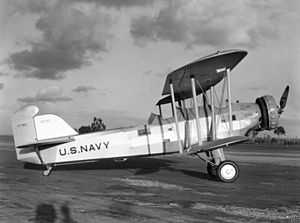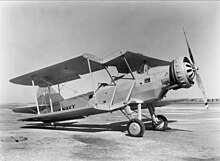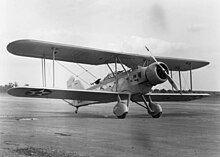| Douglas XT3D | |
|---|---|

| |
| Douglas XT3D-1 | |
| Role | Three-seat torpedo bomberType of aircraft |
| National origin | United States |
| Manufacturer | Douglas Aircraft Company |
| First flight | 1931 |
| Retired | 1941 |
| Primary user | United States Navy |
| Number built | 1 |
The Douglas XT3D was an American three-seat torpedo bomber biplane developed by the Douglas Aircraft Company to meet a United States Navy requirement.
Development

The XT3D torpedo bomber (BuNo 8730) was first flown in 1931, it has been described as a large and ugly aircraft. Of metal construction with a fabric covering the XT3D had folding wings and an arrestor hook for carrier operation. With a fixed tailwheel landing gear and powered by a Pratt & Whitney R-1690 Hornet radial engine, the XT3D had three open cockpits, forward for the gunner/bomb-aimer, centre for the pilot, rear for another gunner.
The XT3D failed to meet the Navy's requirements and after tests was returned to Douglas. It was modified with a more powerful Pratt & Whitney XR-1830-54 radial, and wheel fairings and the two rear cockpits were enclosed. Re-designated XT3D-2, it still failed to pass Navy trials and was not ordered into production. The prototype was used by the Navy for the next ten years for general purpose use until it was relegated as an instructional airframe in 1941.
Variants

- XT3D-1
- Prototype powered by a Pratt & Whitney R-1690 radial, one built.
- XT3D-2
- Prototype modified including a change to a Pratt & Whitney R-1830 radial.
Operators
Specifications
Data from
General characteristics
- Crew: 3 (pilot, bomb-aimer/gunner, gunner)
- Length: 35 ft 5 in (10.80 m)
- Wingspan: 50 ft 0 in (15.24 m)
- Height: 13 ft 2.5 in (4.026 m)
- Wing area: 624 sq ft (58.0 m)
- Empty weight: 4,238 lb (1,922 kg)
- Max takeoff weight: 7,857 lb (3,564 kg)
- Powerplant: 1 × Pratt & Whitney R-1690 Hornet radial piston engine, 575 hp (429 kW)
Performance
- Maximum speed: 128 mph (206 km/h, 111 kn) at 6000ft (1830m)
- Range: 555 mi (893 km, 482 nmi)
- Service ceiling: 14,000 ft (4,300 m)
Armament
- Guns: 2 × 0.3in (7.62mm) machine-gun (flexible mounted on forward and rear cockpits)
- Bombs: 1835lb (832kg) torpedo or equivalent in bombs
See also
Related lists
References
- Notes
- Bibliography
- Andrade, John (1979). U.S.Military Aircraft Designations and Serials since 1909. Midland Counties Publications. ISBN 0-904597-22-9.
- The Illustrated Encyclopedia of Aircraft (Part Work 1982-1985). Orbis Publishing.
| Douglas military aircraft | |
|---|---|
| Fighters | |
| Ground attack | |
| Bombers | |
| Observation | |
| Patrol | |
| Reconnaissance | |
| Transports | |
| Gliders | |
| Training aircraft | |
| Experimental | |
| USN/USMC torpedo aircraft designations pre-1962 | |||||||||||||||||||||
|---|---|---|---|---|---|---|---|---|---|---|---|---|---|---|---|---|---|---|---|---|---|
| Torpedo |
| ||||||||||||||||||||
| Torpedo Bomber |
| ||||||||||||||||||||
| Torpedo Scout |
| ||||||||||||||||||||
| Patrol Torpedo Bomber |
| ||||||||||||||||||||